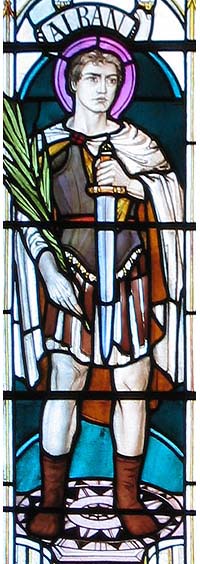 |
 |
|||
|
|
Saint Alban was a pagan soldier in the Roman Army stationed in Britain. His exact background is unknown, but popular tradition declares him a native Briton. Bede says he lived during the religious persecutions of the Emperor Diocletian (c.AD 304), though modern historians have argued for similar circumstances which arose some years earlier, during the reigns of Decius (c. 254) or Septimus Severus (c.209). During these dangerous times, Alban received into his house and sheltered a Christian priest, supposedly named Amphibalus, and was so struck by the devotion to God and blameless life of this man whom he protected, that he placed himself under his instruction and became a Christian. A rumour having reached the governor of Verulamium (now St. Albans), that the priest was hiding in the house of Alban, he sent soldiers to search it. Alban, seeing them arrive, hastily threw the long cloak of the priest over his own head and shoulders and presented himself to the soldiers as the man whom they sought. He was immediately bound and brought before the governor who, at that moment, was standing at one of the civic altars, offering up a sacrifice. When the cloak, which had concealed Alban's face, was removed, it was immediately revealed that he was not the priest whose arrest the governor had ordered. The latter's anger flamed hot and he ordered Alban, immediately, to sacrifice to the gods or to suffer death. St. Alban steadfastly refused
to offer to idols. Then the magistrate asked, "Of what family and
race are you?" When the judge saw that he could not prevail, he ordered Alban to be put to death. On his way to execution, on 20th June, the martyr had to cross a river. "There," says Bede, "he saw a multitude of both sexes, and of every age and rank, assembled to attend the blessed confessor and martyr; and these so crowded the bridge, that he could not pass over that evening. Then St. Alban, urged by an ardent desire to accomplish his martyrdom, drew near to the stream, and the channel was dried up, making a way for him to pass over."' Then the martyr and his escort, followed by an innumerable company of spectators, ascended the hill above Verulamium, now occupied by the abbey church bearing his name. It was then a green hill covered with flowers, sloping gently down into the pleasant plain. However, the executioner refused to perform his office and, throwing down his sword, confessed himself a Christian also. Another man was detailed to deal the blow and both Alban and the executioner, who had refused to strike, were decapitated together. St. Alban's body was buried in the adjoining cemetery and, when Christianity was legalized by the Emperor Constantine the Great, not long afterwards, he was well remembered by the local community who erected a martyrium above his grave. This almost certainly became a place of pilgrimage, even in Roman times. It was famously visited by St. Germanus of Auxere, in AD 429, and, as a small church, survived the pagan Saxon expansion, until the present abbey church was founded on the site, by King Offa of Mercia, in AD 793. Alban's relics were reverred by the devout for centuries, before they eventually disappeared during the Dissolution of the Monasteries. Tradition has it that they were smuggled away to join previously exchanged relics at St. Pantaleon's Church in Cologne. St. Alban should not, however, be confused with St. Albinus from St. Maurice's Church, also in Cologne. In art, St. Alban is represented, sometimes in civil and sometimes in military dress, bearing the palm of martyrdom and a sword, or a cross and a sword. Edited from Baring-Gould's "Lives of the Saints" (1877)
|
|||
| © Nash Ford Publishing 2003. All Rights Reserved. | ||||





 St. Alban
St. Alban